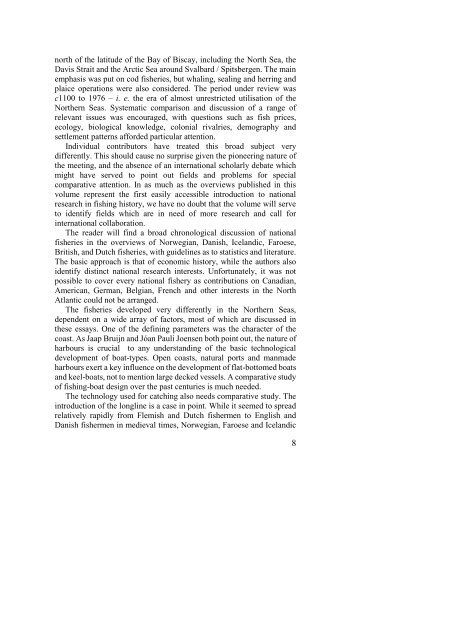The North Atlantic Fisheries, 1100-1976 - University of Hull
The North Atlantic Fisheries, 1100-1976 - University of Hull
The North Atlantic Fisheries, 1100-1976 - University of Hull
Create successful ePaper yourself
Turn your PDF publications into a flip-book with our unique Google optimized e-Paper software.
north <strong>of</strong> the latitude <strong>of</strong> the Bay <strong>of</strong> Biscay, including the <strong>North</strong> Sea, the<br />
Davis Strait and the Arctic Sea around Svalbard / Spitsbergen. <strong>The</strong> main<br />
emphasis was put on cod fisheries, but whaling, sealing and herring and<br />
plaice operations were also considered. <strong>The</strong> period under review was<br />
c<strong>1100</strong> to <strong>1976</strong> – i. e. the era <strong>of</strong> almost unrestricted utilisation <strong>of</strong> the<br />
<strong>North</strong>ern Seas. Systematic comparison and discussion <strong>of</strong> a range <strong>of</strong><br />
relevant issues was encouraged, with questions such as fish prices,<br />
ecology, biological knowledge, colonial rivalries, demography and<br />
settlement patterns afforded particular attention.<br />
Individual contributors have treated this broad subject very<br />
differently. This should cause no surprise given the pioneering nature <strong>of</strong><br />
the meeting, and the absence <strong>of</strong> an international scholarly debate which<br />
might have served to point out fields and problems for special<br />
comparative attention. In as much as the overviews published in this<br />
volume represent the first easily accessible introduction to national<br />
research in fishing history, we have no doubt that the volume will serve<br />
to identify fields which are in need <strong>of</strong> more research and call for<br />
international collaboration.<br />
<strong>The</strong> reader will find a broad chronological discussion <strong>of</strong> national<br />
fisheries in the overviews <strong>of</strong> Norwegian, Danish, Icelandic, Faroese,<br />
British, and Dutch fisheries, with guidelines as to statistics and literature.<br />
<strong>The</strong> basic approach is that <strong>of</strong> economic history, while the authors also<br />
identify distinct national research interests. Unfortunately, it was not<br />
possible to cover every national fishery as contributions on Canadian,<br />
American, German, Belgian, French and other interests in the <strong>North</strong><br />
<strong>Atlantic</strong> could not be arranged.<br />
<strong>The</strong> fisheries developed very differently in the <strong>North</strong>ern Seas,<br />
dependent on a wide array <strong>of</strong> factors, most <strong>of</strong> which are discussed in<br />
these essays. One <strong>of</strong> the defining parameters was the character <strong>of</strong> the<br />
coast. As Jaap Bruijn and Jóan Pauli Joensen both point out, the nature <strong>of</strong><br />
harbours is crucial to any understanding <strong>of</strong> the basic technological<br />
development <strong>of</strong> boat-types. Open coasts, natural ports and manmade<br />
harbours exert a key influence on the development <strong>of</strong> flat-bottomed boats<br />
and keel-boats, not to mention large decked vessels. A comparative study<br />
<strong>of</strong> fishing-boat design over the past centuries is much needed.<br />
<strong>The</strong> technology used for catching also needs comparative study. <strong>The</strong><br />
introduction <strong>of</strong> the longline is a case in point. While it seemed to spread<br />
relatively rapidly from Flemish and Dutch fishermen to English and<br />
Danish fishermen in medieval times, Norwegian, Faroese and Icelandic<br />
8















